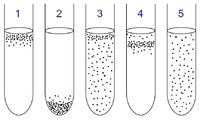
Photo from wikipedia
BackgroundThe existence of latent low-virulence anaerobic bacteria in degenerated intervertebral discs (IVDs) remains controversial. In this study, the prevalence of low-virulence anaerobic bacteria in degenerated IVDs was examined, and the… Click to show full abstract
BackgroundThe existence of latent low-virulence anaerobic bacteria in degenerated intervertebral discs (IVDs) remains controversial. In this study, the prevalence of low-virulence anaerobic bacteria in degenerated IVDs was examined, and the correlation between bacterial infection and clinical symptoms was analysed.MethodsEighty patients with disc herniation who underwent discectomy were included in this study. Under a stringent protocol to ensure sterile conditions, 80 disc samples were intraoperatively retrieved and subjected to microbiological culture. Meanwhile, tissue samples from the surrounding muscle and ligaments were harvested and cultured as contamination markers. The severity of IVD degeneration and the prevalence of Modic changes (MCs) were assessed according to preoperative MRI analysis.ResultsOf the 80 cultured discs, 54 were sterile, and 26 showed the presence of bacteria: Propionibacterium acnes (21 cases) and coagulase-negative staphylococci (5 cases). MRI revealed that the presence of bacteria was significantly associated with MCs (P<0.001). However, there was no significant association between bacterial infection and the severity of IVD degeneration (P = 0.162).ConclusionsOur findings further validated the presence of low-virulence anaerobic bacteria in degenerated IVDs, and P. acnes was the most frequent bacterium. In addition, the latent infection of bacteria in IVDs was associated with Modic changes. Therefore, low-virulence anaerobic bacteria may play a crucial role in the pathophysiology of MCs and lumbar disc herniation.
Journal Title: BMC Musculoskeletal Disorders
Year Published: 2018
Link to full text (if available)
Share on Social Media: Sign Up to like & get
recommendations!